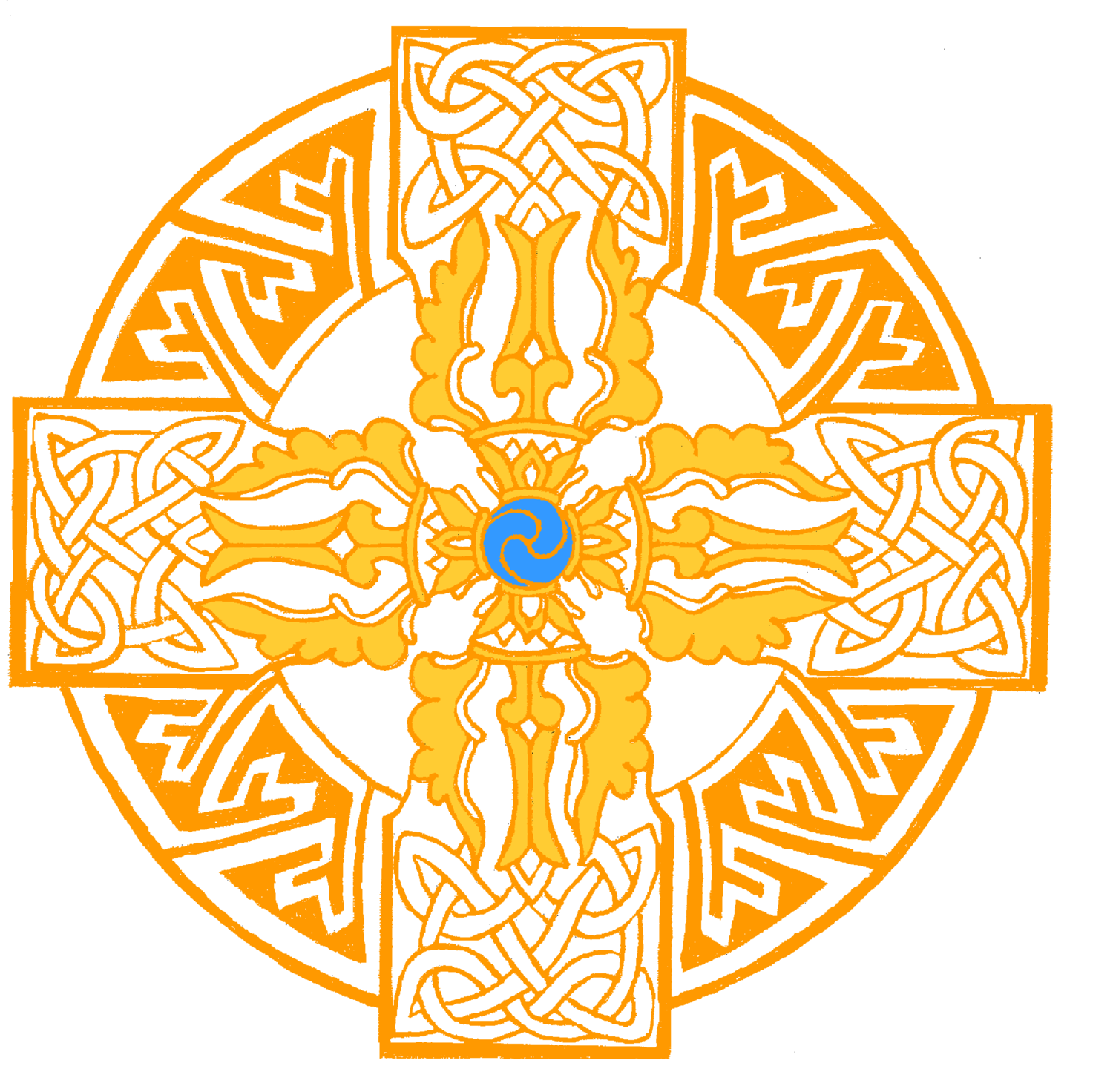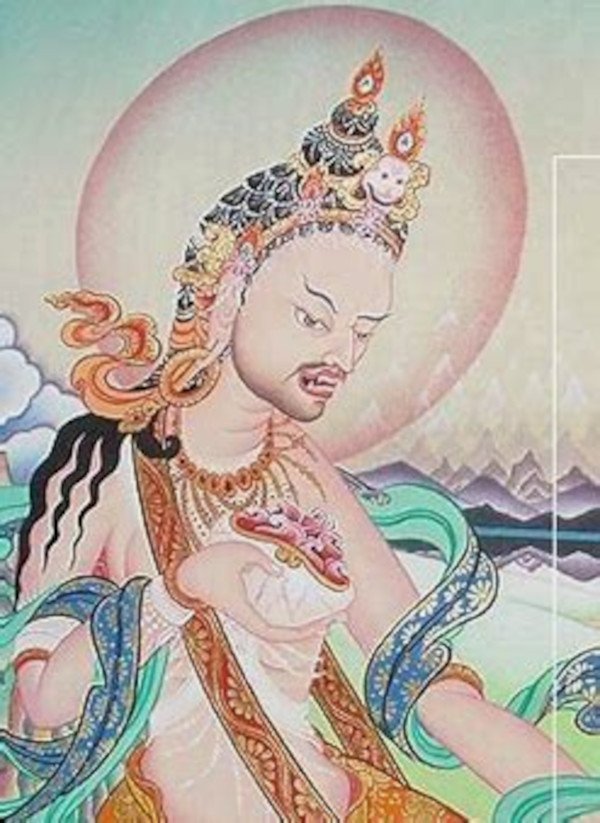Practices
Seonaidh Yeshe Tungpa's practice supports: bell, meteorite phurba, dorje, mala,Vajrapani, Trungpa Rinpoche photo, 4-armed deity painting.
Crazy Heart Lineage
(chanted slowly)
The foundation of samaya is communication of the heart.
Then the primordial state of being is important
Which is the experience of being
Primordially without complexity
This is the experience of basic unconditioned space.
From that we develop a sense of purity and goodness
Constantly people everywhere are seeking this.
We try to find a mate in the largest
Sense of the word.
We wander everywhere searching.
From that we begin to realize that
We are searching too much.
In the end we never find a mate.
This is called being free
From the limits of oneself.
Because of this we begin
To appreciate mandala.
Collective experiences are put together
In an enlightened way.
Softness takes place in our ayatanas.
Our projections function at a greater level
Of homogeneous existence of ourself
And the other.
We look at our projections and see
They don't function as well as we thought.
Things begin to happen beyond what we perceive
The whole thing is turned inside out.
Still we are proud of it.
Our inner absolute realization is good
The external and internal mandalas
Inseparably mix.
We mix them, therefore we seem crazy.
Our mind expands in Dharmdhatu
The space of dharmas.
Everything interpenetrates and we seem crazy.
This is the goal
This is the goal
This is the goal
Of the Crazy Heart Lineage.
(Written by Chogyam Trungpa Rinpoche, Heart teacher of Seonaidh Perks.)
OM AH HUM
SONG OF GURU YOGA
The three yana journey from Hinayana to Mahayana and then Vajrayana is one in which methods are utilized to in a sense create the conditions for stumbling into the awakened state. In Hinayana we are introduced to meditation and can learn the discipline of controlling the senses and no longer allowing the body to be ruled by thoughts. In the Mahayana the journey expands further and one learns how to cultivate the Paramitas that enrich the field and grow ripe the Bodhicitta necessary to engage the other. There are many methods for training the mind and the culmination is to have taken a seat on a thin razor's edge; the place where neither this or that hold complete sway------Buddhists call this the middle way.
When one moves into the Vajrayana the cool, clean and clinical aspect of Buddhism goes away. It doesn't mean one's training is gone too, it will be needed to hold the View to stay firmly balanced on the thin razor's edge. In traditional settings when one moves into this stage of the journey the refuge changes slightly and guru is put above even the Buddha. The principle of Buddha as safe haven is gone and one's life must become surrendered to guru. In guru yoga the practice is to be in "union" or in yoga with the guru's mind-----yoga is the practice of non-duality, unifying supposed opposites, in this case your mind and the guru's mind. This type of wild awakening is the essence of tantra. Tantra in any tradition it is utilized in, is the fast or swift path, it will escalate one's journey. To practice this yoga you have to stay on that razor's edge; what helps is honey on the blade and the honey is Bhakti or devotion.
This may for some Buddhists reek of theism and that would be a keen observation. But as far as the experience goes we are no longer in the realm of concepts and debate between theism and non-theism------guru yoga is a ride or die bitch situation or as Seonaidh would say a choice of either chickening in or chickening out. But even that can give you a sense that you somehow have a choice. The guru is energy and to meet a real life guru is to contact the centre of an energetic mandala. The centre is formless and now appearance takes on a whole different relation to one's journey---maybe you want to get off but there is no place to go or maybe you want to take a break to understand, but the energy is working through you and not with your old schemes or games. You are now trapped in the guru's mandala and you can either stick with the training that brought you here or get beat down by the appearance you soon realize is not in your control and never was. In this way there is no turning back. To work with guru yoga one has to surrender choice and surrender the willfulness that you have been training up to this point. Buddhism can give you the sense that the whole journey will be as clean and clinical as the Hinayana and Mahayana but in guru yoga you quickly realize that that is not the case. It seems like a raw deal having to surrender such a cleaned up and precise mind, but all that tidyness was just illusion of path, in guru yoga you are now on the non-journey and non-path aspect of the three yana experience. Guru stands above even Buddha here and many find that question and answer periods provide no real safe delusion to hide in, we are exposed and must surrender.
Traditionally the wild awakenings of the Vajrayana can be discussed in Kagyu yogi terms as Mahamudra or Great Symbol and as well as an even older approach by the Nyingmas called Dzogchen. The difference here is that in Mahamudra one is playing with appearance realizing emptiness there and in Dzogchen one plays in emptiness while realizing it as appearance. These seemingly opposite paths are yogas where the practitioner is unifying with experience. This is as far as concepts and words allow because yoga is not about forcing two into one, but its a returning to the unified state of all phenomena. The not two field of awareness is non-dualism in motion and in experience not in concept and in understanding. In Mahamudra the experience is the play of guru and the trained mind (with proper honey of devotion) can balance on the razor's edge no matter what deity the guru takes; be it wrathful or peaceful one; the yoga is to unify the seemingly dualistic experience. In Dzogchen one maintains the mind of emptiness as appearance is illuminated by the guru and the yoga here is to become unified with that seemingly separate illumination (because it is not ultimately separate; nor is the guru). In both cases there is no longer separations like what is sacred or profane, all is included and unified within the field of awareness-----this is the guru's "leela" or play, the field of awareness where all experience is teaching; it is the essence of living Dharma.
Guru yoga puts you ever closer to the cliff's edge or the great falling over that will need to occur to awaken fully. This awakening which is all of our birth rights, is as close as our eyelashes and for those that awaken to it, they are like daytime stars. The path of surrender may sound Holy and good and it is, but it comes at a cost and not a cost that can be conceptualized. The cost is full surrender. A good practice for this surrendering is prostrations. Many lineages recommend a certain number and depending on your journey and karma you could end up doing it over and over again. It is the nuts and bolts of guru yoga. Other practices of offering mandala and even deity yoga are methods to work with particular obstacles to this full surrender. Once the guru is in your life in this yoga, all seeming pleasantries and calamities are seen as the leela of guru, and when we can't see that or work with that we must continue the whittling down of our willfulness through practices like prostrations, mandala offering and so on. There is no set time period or number of practices this all depends on yourself-------the jumping off the cliff part is your very own and will be different from all other people's journey------the guru puts you on that cliff's edge over and over until the day you decide to jump over finally (that will be entirely up to you and your capacity).
May this brief song about Guru Yoga meet the hearts of sincere practitioners. Requested by and written spontaneously in honour and love of HH Seonaidh Yeshe Tungpa Perks on this December Bodhi Day, 2021. Dedicated as well to the "corker" HE Traktung Khepa.
May all awaken swiftly........
thom indrabodhi kilts
Mahasiddha Tilopa
Tilpoa’s Six Nails of Key Points (Six Words of Advice) given to Naropa:
McLeod translation
Ken McLeod rendered this text in English (with a brief explanation of each Tibetan term) as follows:[1]
Don’t recall. (Let go of what has passed.)
Don’t imagine. (Let go of what may come.)
Don’t think. (Let go of what is happening now.)
Don’t examine. (Don’t try to figure anything out.)
Don’t control. (Don’t try to make anything happen.)
Rest. (Relax, right now, and rest.)
In other words:
Do not ponder, think, or cognize. Do not meditate or examine. Leave the mind to itself. Rest in whatever arises.
The Short Liturgy of Vajrakaya
The Guru Yoga of Undying Vajradhatu
Saraha Doha (inspirational song)
Chenrezig Sadhana (visualization and text for Avalokiteshvara /Chenrezig practice)
A Guru Yoga Practice (16th Karmapa)
Commentary on Guru Yoga Practice




